反应工程英文论文
化学论文英文版

化学论文英文版Jun-Ke Wang, Ying-Xiao Zong, Xi-Cun Wang, Yu-Lai Hu, Guo-Ren Yue.Synthesisof N-benzothiazol-2-yl-amides by Pd-catalyzed C(sp2)-H functionalization[J]. CCL, 2015,26(11): 1376-1380Synthesis of N-benzothiazol-2-yl-amides byPd-catalyzed C(sp2)-H functionalizationJun-Ke Wang a,b,c, Ying-Xiao Zong a,b, Xi-Cun Wang a,b, Yu-Lai Hu a,b,Guo-Ren Yue aa Key Laboratory of Hexi Corridor Resources Utilization of Gansu Universities, College of Chemistry and Chemical Engineering, Hexi University, Zhangye 734000, China;b Gansu Key Laboratory of Polymer Materials, College of Chemistry and Chemical Engineering, Northwest Normal University, Lanzhou 730070, China;c Gansu Engineering Laboratory of Applied Mycology, Hexi University, Zhangye 734000, ChinaReceived 11 May 2015, Received in revised form 29 June 2015, Accepted 1 July 2015,Available online 10 August 2015.E-mail addresses: wangxicun@;huyulai@Abstract: A catalytic synthesis of N-benzothiazol-2-yl-amides from1-acyl-3-(phenyl)thioureas was achieved in the presence of a palladium catalyst through the C(sp2)-H functionalization/C-S bond formation. This synthetic methodology can produce various N-benzothiazol-2-yl-amides in high yields with good functional group tolerance.Key words: Benzothiazole Pd-catalyzed1-Acyl-3-phenylthiourea C-H functionalization L-Proline1. IntroductionThe benzothiazole moiety is an important scaffold due to its widespread occurrence in bioactive natural products,pharmaceuticals, organic optoelectronic materials,and ligands for phosphorescent complexes [1-4]. In particular,substituted Nbenzothiazol- 2-yl-amides are an important class of heterocyclic compounds that exhibit a wide range of biological properties [5-9] such as ubiquitin ligaseinhibition [5],antitumor [6],antirotavirus infections [7],modulating the adenosine receptor [8, 9],and the nuclear hormone receptor [9]. For example,the N-benzothiazol-2- yl-cyclohexanecarboxamide,as a new anticancer drug,was selected as one of the most promising screening hit compounds (Fig. 1) [6]. The acylation reaction from2-aminobenzothiazole,one of the classical methods for the preparation of these molecules [5, 6],is known for the limited diversity of the commercially available starting materials. Furthermore,the preparation of 2-aminobenzothiazole also required the use of the toxic bromine.The past several years have witnessed the great progress in the development of the C-S bond formation promoted by transition metals,which can provide moreefficient,practical,and straightforward approaches to valuable sulfur-containing compounds [10, 11]. However,these methods have been mainly focused on the‘‘traditional’’ cross-coupling reactions of ArX (X = Cl,Br,I,OTf,and B(OH)2) and sulfides [12-39]. To achieve greener and more atomeconomic C-S bond formations,transition metal-catalyzed direct oxidative cross-coupling of C-H bonds and sulfides would be ideal [40-47].In our previous work,we have shown that N-benzothiazol-2-ylamides can be synthesized smoothly by Cu-catalyzed intramolecular cyclization of various substituted 1-acyl-3-(2-bromophenyl) thioureas [48]. This method can provide more diversiform Nbenzothiazol- 2-yl-amides through the carbon-heteroatom formation under relatively mild conditions and avoid the use of the toxic bromine. However,the drawback of this procedure is the limited diversity of the commercially available starting materials due to the use of substituted ortho-haloarylamines. In order to further extend the diversity of N-benzothiazol-2-yl-amides,we have recently demonstrated an efficient intramolecular cyclization of substituted 1-acetyl-3-(2-phenyl)thiourea catalyzed by iron through C-H functionalization [49]. This method can provide more diversiformN-benzothiazol-2-yl-amides under relatively mild conditions. However,the purification of the target compounds is challenging using the column chromatography or recrystallization,since it is inescapable to obtain 1-acetyl-3-phenylurea whose polarity is similar to that of 1-acetyl-3-(2-phenyl)thiourea. Recently,Doi’s group[46] reported a Pd-catalyzed synthesis of 2-substituted benzothiazoles via a C-H Functionalization reaction. Therefore,we envisioned that Pd-catalyzed cyclization of 1-acyl-3-(2-phenyl)- thiourea 1would represent a viable method for the formation and purification of substituted N-benzothiazol-2-yl-amides 2(Scheme 1).2. ExperimentalAll reagents were commercially available and used as supplied. Dimethyl sulfoxide (DMSO) was dried and distilled from calcium hydride. N,N-Dimethylformamide (DMF),toluene,DME and CH3CN were dried prior to use using standard methods. Unless otherwise stated,analytical grade solvents and commercially available reagents were used as received. Thin layer chromatography (TLC) employed glass 0.20 mm silica gel plates. Flash chromatography columns were packed with 200-300 mesh silica gel.All new compounds were characterized by IR,1H NMR,13C NMR and HRMS. The known compounds were characterized by 1H NMR, 13C NMR and HRMS. The IR spectra were run on a Nicolete spectrometer (KBr). The 1H NMR and 13C NMR spectra were recorded on a BRUKER AVANCEIII 400 MHz spectrometer. The chemical shifts (d) were given in parts per million relative to an internal standard tetramethylsilane. High resolution mass spectra (HRMS) were measured with a Waters Micromass GCT instrument and accurate masses were reported for the molecular ion (M+). Melting points were determined on a Perkin-Elmer differential scanning calorimeter and the thermometer was uncorrected.2.1. General procedure for the synthesis of1-acyl-3-arylthioureas [49, 50]To a 25 mL round-bottom flask equipped with a magnetic stirring bar was added acyl chloride (10 mmol),NH4SCN (15 mmol) and CH2Cl2 (20 mL),followed by PEG-400 (0.1 mmol). The mixture was stirred for approximately 3 h at room temperature. Aromatic amine (10 mmol) was added to the mixture and stirred for another 2 h at room temperature. The solvent was removed under reduced pressure to give the resulting residue as a solid,which was washed with water three times,to give the crude product.The analytical samples were obtained by recrystallization from C2H5OH in good yields ([4TD$DIF]88%-98%).2.2. General procedure for the synthesis ofN-benzothiazol-2-ylamides by aPd-catalysed C(sp2)-H functionalization reactionA round-bottom flask equipped with a stirring bar was charged with1-acyl-3-arylthioureas (1 mmol),PdCl2 (10 mol%),CuI (20 mol%),Cs2CO3 (2 equiv.),and L-proline (20 mol%) in 5 mL of DMSO. The mixture was stirred at 100 ℃for the indicated time in Table 2. After cooling to room temperature,the reaction mixture was extracted with ethyl acetate (10 mL × 3). The organic layers were combined,dried over Na2SO4 and concentrated under reduced pressure,and then purified by silica gel chromatography (acetone/petroleum ether = 1:4) to yield the desired product2.N-(4-Ethylbenzo[d]thiazol-2-yl)acetamide (2f): A gray solid (80% yield); mp:264-268 ℃; IR (cm-1): 3169.9,2990.1,2359.9, 1661.1,1550.4; 1H NMR (400MHz,CDCl3): δ 9.42 (s,1H),7.67 (dd, 1H,J = 6.3,2.9 Hz),7.27 (dd,2H,J = 4.4,1.9 Hz),3.04 (q,2H, J = 7.6 Hz),2.28 (s,3H),1.34 (t,3H,J = 7.6 Hz); 13C NMR (100 MHz,CDCl3): δ171.64(s),156.91 (s),146.45 (s),136.81 (s),131.98 (s), 125.25 (s),124.22 (s),118.92 (s),25.36 (s),23.51 (s),14.79 (s); HRMS calcd. for C11H12N2OS [M]+:220.0670; found [5TD$DIF]200.0678.N-(6-Fluorobenzo[d]thiazol-2-yl)acetamide (2 g): A white solid (94% yield); mp:224-231 ℃; IR (cm-1): 3207.8,3071.0,2983.9, 2360.4,1689.2; 1H NMR (400MHz,CDCl3): δ 7.70 (dd,1H,J = 8.9, 4.6 Hz),7.53 (dd,1H,J = 8.0,2.5 Hz),7.19 (td,1H,J = 8.9,2.6 Hz), 2.31 (s,3H); 13C NMR (100 MHz,CDCl3): δ 168.33 (s),160.93 (s), 158.50 (s),121.30 (d,J = 9.1 Hz),114.75 (s),108.09 (s),107.82 (s), 23.46 (s); HRMS calcd. for C9H7FN2OS [M]+: 210.0263; found 210.0256.3. Results and discussionWhile not commercially available,benzothioureas are stable and easilysynthesized [50, 51] from inexpensive starting materials in high yields on a multigram scale. Following Scheme 2,the synthesis of benzothioureas can be achieved in a straightforward manner starting from inexpensive aryl acid chloride and arylamines. Aryl acid chloride was treated with ammonium sulfocyanide in the presence of PEG-400in CH2Cl2,followed by the addition of arylamines,to obtain 1-arylacyl-3-phenylthiourea in good to excellent yields. This intermediate can be used directly without further purifications.In a preliminary experiment,we investigated the intramolecular C-S bond formation of 1-acetyl-3-phenylthiourea utilizing PdCl2 (20%) and a mild base (K2CO3,2 equiv.) in DMSO for 20 h at 100 ℃(Table 1,entry 1). However,the reaction almost failed to take place. Subsequently,we screened several metal salts as cocatalysts, includingAlCl3,CuCl2,Cu(OAc)2,CoCl2,NiCl2,FeCl3,CuI, and CuCl,and found that the addition of CuI considerably enhanced this reaction (Table 1,entries 2-8). However,the desired yield was still not obtained. Surprisingly,when Doi’s condition was used,the yield was still very low (42%) (Table 1,entry 9). Generally,the choice of the ligands is important for the reaction catalyzed by the metal,which prompted us to explore the effect of several bidentate ligands. We carried out the reaction of 1-acetyl-3-phenylthiourea by screening these ligands,such as 1,10-phenanthroline,β-keto esters,β-diketones,andL-proline. (Table 1,entries 10-13),and we were pleased to find that the use of these ligands can notably improve the yield of the product under the same conditions,and that L-proline proved to be the best among an array of ligands tested (Table 1,entry 14). When the amount of CuI and PdCl2 was decreased to 20 mol% and 10mol%,respectively,the catalytic activity was maintained (Table 1,entry 14). Furthermore,we also investigated other bases (Cs2CO3 and K3PO4) (Table 1,entries 15- 16),solvents (DMF,DME,and toluene) (Table 1,entries 17-19) and reaction time (Table 1,entries 20-21). When only CuI was used in this cyclization,no reaction can take place (Table 1,entry 22). Thus, the optimized reaction conditions are as the follows: substrate (1 mmol),PdCl2 (10 mol%),CuI (20 mol%),Cs2CO3 (2 equiv.), L-proline (20 mol%) in DMSO (4 mL) within 8 h at 100 ℃.In response to this encouraging result,we used a range of substituted1-acetyl-3-(phenyl)thioureas to investigate the scope and limitation of this reaction. The corresponding products were obtained in excellent yields (88%-98%). The results obtained under the optimized conditions are listed in Table 2. Initially,the substituents of phenyl were screened. The results demonstrate that little effect of the substituted groups on the benzene ring was observed for this transformation.Furthermore,substituents at different positions of the phenyl ring do not significantly affect the efficiency (Table 2,entries 1-8). It is noteworthy that the halosubstituted benzenes survived leading to halo-substituted products,which can be used for further transformations (Table 2, entries 2,7,8 and 11). In order to make the new Sankyo investigational drugs,the R group was selected as a cyclohexyl to give the corresponding products (Table 2,entries 10-12).Although extensive studies on reaction mechanism have not yet been carried out,the proposed mechanism can be proposed according to the similar palladium-catalyzed processes [51] (Scheme 3). 1-Acetyl-3-(phenyl)thiourea was converted to the thioenolate in the presence of Cs2CO3. Pre-association of the sulphur atom in the thioenolate to Pd(OAc)2 facilitates the orthopalladation process with the concomitant release of chloride ion. The formation of the six-membered palladacycle and the subsequent reductive elimination leads to N-benzothiazol-2-yl-amide and Pd(0). The Pd(0) species are reoxidized to Pd(II) by CuI,thus completing the catalytic cycle.4. ConclusionIn conclusion,we have achieved an efficient intramolecular cyclization of substituted 1-acetyl-3-(2-phenyl) thioureas catalyzed by palladium(II) catalysts through C(sp2)-H functionalization. This method can provide more diversiform N-benzothiazol-2-yl-amides efficiently and quickly in high yields under relatively mild conditions. The combination of the generality with respect to the substrate scope and facile accessibility to the starting materials may generate numerous synthetic possibilities. Further mechanistic analysis of these reactions will be the subject of future work.AcknowledgmentsThis work was supported by the National Natural Science Foundation of China (Nos. 21462016,21262010),Natural Science Foundation of Gansu Province and the Advanced Research Fund of Jinchuan Group Co.,Ltd.References[1] R.S. Keri, M.R. Patil, S.A. Patil, S. Budagumpi, A comprehensive review in currentdevelopments of benzothiazole-based molecules in medicinal chemistry, Eur. J.Med. Chem. 89 (2015) 207-251.[2] A. Rouf, C. Tanyeli, Bioactive thiazole and benzothiazole derivatives, Eur. J. Med.Chem.97 (2015) 911-927.[3] A.G. DiKundar, G.K. Dutta, T.N. Guru Row, S. Patil, Polymorphism inopto-electronic materials with a benzothiazole-fluorene core: a consequence of high conformational flexibility of p-conjugated backbone and alkyl sidechains, Cryst. Growth Des. 11 (2011) 1615-1622.[4] T. Girihar, W. Cho, Y.H. Kim, et al., A systematic identification of efficiencyenrichment between thiazole and benzothiazole based yellow iridium(III)complexes, J. Mater. Chem.2 (2014) 9398-9405.[5] F. Parlati, U.V. Ramesh, R.P. Singh, et al., Benzothiazole and thiazole5,5-bipyridine compositions and their use as ubiquitin ligase inhibitors, PCT Int.Appl. WO 2005037845, 2005.[6] M. Yoshida, I. Hayakawa, N. Hayashi, et al., Synthesis and biological evaluation ofbenzothiazole derivatives as potent antitumor agents, Bioorg. Med. Chem. Lett. 15 (2005) 3328-3332.[7] T.R. Bailey, D.C. Pevear, Benzothiazol compounds, compositions and methods fortreatment and prophylaxis of rotavirus infections and associated diseases, PCT Int. Appl. WO 2004078115, 2004.[8] A. Alanine, A. Flohr, A.K. Miller, R.D. Norcross, C. Riemer, Benzothlazolederivatives, PCT Int. Appl. WO 2001097786, 2001.[9] S. Kerwin, L.H. Hurley, M.R. De, Compounds and method for providingpharmacologically active preparation and uses thereof, PCT Int. Appl.WO9748694, 1997.[10] H. Liu, X. Jiang, Transfer of sulfur: from simple to diverse, Chem. Asian J. 8 (2013)2546-2563.[11] D.V. Partyka, Transmetalation of unsaturated carbon nucleophiles fromboroncontaining species to the mid to late block metals of relevance to catalytic C-X coupling reactions (X = C, F, N, O, Pb, S, Se, Te), Chem. Rev.111 (2011)1529-1595.[12] H. Yu, M. Zhang, Y. Li, Copper-catalyzed synthesis of benzo[b]thiophenes andbenzothiazoles using thiocarboxylic acids as a coupling partner, J. Org. Chem. 78 (2013) 8898-8903.[13] H. Deng, Z. Li, F. Ke, X. Zhou, Cu-catalyzed three-component synthesis ofsubstituted benzothiazoles in water,Chem. Eur. J.18 (2012) 4840-4843.[14] H.J. Xu, Y.Q. Zhao, T. Feng, Y.S. Feng, Chan-lam-type S-arylation of thiols withboronic acids at room temperature, J. Org. Chem.77 (2012) 2878-2884.[15] D.J.C. Prasad, G. Sekar, Cu-catalyzed one-pot synthesis of unsymmetrical diarylthioethers by coupling of aryl halides using a thiol precursor, Org. Lett. 13 (2011) 1008-1011.[16] L.L. Sun, C.L. Deng, R.Y. Tang, X.G. Zhang, CuI/TMEDA-catalyzed annulation of 2-bromo alkynylbenzenes with Na2S: synthesis of benzo[b]thiophenes, J. Org.Chem.76 (2011) 7546-7550.[17] H.L. Kao, C.F. Lee, Efficient copper-catalyzed s-vinylation of thiols with vinylhalides, Org. Lett. 13 (2011) 5204-5207.[18] F. Ke, Y. Qu, Z. Jiang, et al., An efficient copper-catalyzed carbon-sulfur bondformation protocol in water, Org. Lett.13 (2011) 454-457.[19] D. Chen, Z.J. Wang, W. Bao, Copper-catalyzed cascade syntheses of2H-benzo[ b][1,4]thiazin-3(4H)-ones and quinoxalin-2(1H)-ones throughcapturing S and N atom respectively from AcSH and TsNH2, J. Org. Chem. 75(2010) 5768- 5771.[20] C.L. Li, X.G. Zhang, R.Y. Tang, P. Zhong, J.H. Li, Copper-catalyzed thiolationannulations of 1,4-dihalides with sulfides leading to 2-trifluoromethylbenzothiophenes and benzothiazoles, J. Org. Chem.75 (2010) 7037-7040.[21] W. You, X. Yan, Q. Liao, C. Xi, Cu-catalyzed double s-alkenylation of potassiumsulfide: a highly efficient method for the synthesis of various thiophenes, Org.Lett. 12 (2010) 3930-3933.[22] Y. Jiang, S. Xie, Y. Qin, X. Zhang, D. Ma, A general and efficient approach to arylthiols: CuI-catalyzed coupling of aryl lodides with sulfur and subsequentreduction, Org. Lett. 11 (2009) 5250-5253.[23] S. Murru, P. Mondal, R. Yella, B.K. Patel, Copper(I)-catalyzed cascade synthesis of2-substituted 1,3-benzothiazoles: direct access to benzothiazolones, Eur. J. Org.Chem. (2009) 5406-5413.[24] S. Murru, H. Ghosh, S.K. Sahoo, B.K. Patel, Intra- and intermolecular C-S bondformation using a single catalytic system: first direct access toarylthiobenzothiazoles, Org. Lett. 11 (2009) 4254-4257.[25] C.G. Bates, P. Saejueng, M.Q. Doherty, D. Venkataraman, Copper-catalyzedsynthesis of vinyl sulfides 6 (2004) 5005-5008.[26] Z. Qiao, H. Liu, X. Xiao, et al., Efficient access to 1,4-benzothiazine:palladiumcatalyzed double C-S bond formation using Na2S2O3 as sulfuratingreagent, Org. Lett. 15 (2013) 2594-2597.[27] M. Kuhn, F.C. Falk, J. Paradies, Palladium-catalyzed C-S coupling: access tothioethers, benzo[b]thiophenes, and thieno[3,2-b]thiophenes, Org. Lett.13(2011) 4100-4103.[28] C.C. Eichman, J.P. Stambuli, Zinc-mediated palladium-catalyzed formation ofcarbon-sulfur bonds, J. Org. Chem. 74 (2009) 4005-4008.[29] T. Dahl, C.W. Tornoe, B. Bang-Andersen, P. Nielsen, M. Jorgensen,Palladiumcatalyzed three-component approach to promazine with formation of one carbon- sulfur and two carbon-nitrogen bonds, Angew. Chem. Int. Ed. 47(2008) 1726-1728.[30] J.Y. Lee, P.H. Lee, Palladium-catalyzed carbon-sulfur cross-coupling reactionswith indium tri(organothiolate) and its application to sequential one-potprocesses, J. Org. Chem.73 (2008) 7413-7426.[31] M.A. Fernandez-Rodroeguez, Q. Shen, J.F. Hartwig, A general and long-livedcatalyst for the palladium-catalyzed coupling of aryl halides with thiols, J. Am.Chem. Soc. 128 (2006) 2180-2181.[32] M. Iwasaki, M. Iyanaga, Y. Tsuchiya, et al., Palladium-catalyzed direct thiolation ofaryl C-H bonds with disulfides, Chem. Eur. J. 20 (2014) 2459-2462.[33] X.B. Xu, J. Liu, J.J. Zhang, Y.W. Wang, Y. Peng, Nickel-mediated inter- andintramolecular C-S coupling of thiols and thioacetates with aryl Iodides at room temperature, Org. Lett. 15 (2013) 550-553.[34] N. Sakai, T. Miyazaki, T. Sakamoto, et al., Single-step thioetherification byindiumcatalyzed reductive coupling of carboxylic acids with thiols, Org. Lett.14 (2012) 4366-4369.[35] Y. Yang, W. Hou, L. Qin, et al., Rhodium-catalyzed directed sulfenylation of areneC-H bonds, Chem. Eur. J.20 (2014) 416-420.[36] Y.Y. Lin, Y.J. Wang, C.H. Lin, J.H. Cheng, C.F. Lee, Synthesis of alkenyl sulfidesthrough the iron-catalyzed cross-coupling reaction of vinyl Halides with thiols, J.Org. Chem.77 (2012) 6100-6106.[37] V.P. Reddy, K. Swapna, A.V. Kumar, K.R. Rao, Indium-catalyzed C-S cross-couplingof aryl halides with thiols, J. Org. Chem.74 (2009) 3189-3191.[38] M. Arisawa, T. Suzuki, T. Ishikawa, M. Yamaguchi, Rhodium-catalyzed substitutionreaction of aryl fluorides with disulfides: p-orientation in the polyarylthiolation of polyfluorobenzenes, J. Am. Chem. Soc.130 (2008) 12214-12215.[39] Y.C. Wong, T.T. Jayanth, C.H. Cheng, Cobalt-catalyzed aryl-sulfur bondformation, Org. Lett.8 (2006) 5613-5616.[40] H. Wang, L. Wang, J. Shang, et al., Fe-catalysed oxidative C-H functionalization/C-S bond formation, Chem. Commun.48 (2012) 76-78.[41] Y. Cheng, J. Yang, Y. Qu, P. Li, Aerobic visible-light photoredox radical C-Hfunctionalization: catalytic synthesis of 2-substituted benzothiazoles, Org. Lett.14 (2012) 98-101.[42] F. Jia, Z.P. Li, Iron-catalyzed/mediated oxidative transformation of C-Hbonds, Org. Chem. Front. 1 (2014) 194-214.[43] L. Chu, X. Yue, F.L. Qing, Cu(II)-mediated methylthiolation of aryl C-H bonds withDMSO, Org. Lett. 12 (2010) 1644-1647.[44] X. Zhang, W. Zeng, Y. Yang, H. Huang, Y. Liang, Copper-catalyzed double C-Sbonds formation via different paths: synthesis of benzothiazoles from N-benzyl- 2-iodoaniline and potassium sulfide, Org. Lett. 16 (2014) 876-879.[45] K. Inamoto, Y. Arai, K. Hiroya, T. Doi, Palladium-catalysed direct synthesis ofbenzo[b]thiophenes from thioenols, Chem. Commun. 43 (2008) 5529- 5531.[46] K. Inamoto, C. Hasegawa, K. Hiroya, T. Doi, Palladium-catalyzed synthesis of 2-substituted benzothiazoles via a C-H functionalization/intramolecular C-S bond formation process, Org. Lett.10 (2008) 5147-5150.[47] J.K. Wang, F. Peng, J.L. Jiang, et al., Synthesis of N-benzothiazol-2-yl-amides by acopper-catalyzed intramolecular cyclization process, Tetrahedron Lett. 49 (2008) 467-470.[48] J.K. Wang, Y.X. Zong, Y.X. Zhang, et al., Synthesis of N-benzothiazol-2-yl-amidesby a Fe-catalyzed oxidative C(sp2)-H functionalization, Synlett 25 (2014) 2143- 2148.[49] X.C. Wang, Z. Li, Y. Tu, Y.X. Da, Synthesis of N-(5-aryloxymethyl-1,3,4-thiadiazol-2-yl)-N'-(5-aryl-2-furoyl)-thioureas under phase transfer catalysis, Synth.Commun.32 (2002) 1113-1119.[50] Z. Li, X.C. Wang, Synthesis of1-aryloxyacetyl-4-(4-nitrobenzoyl)-thiosemicarabzides under phase transfercatalysis and microwave irradiation, Synth. Commun.32 (2002) 3087-3092.[51] K. Inamoto, T. Saito, M. Katsuno, T. Sakamoto, K. Hiroya, Palladium-catalyzed C-Hactivation/intramolecular amination reaction: a new route to3-aryl/alkylindazoles, Org. Lett. 9 (2007) 2931-2934.。
The durability of concrete 英文版混凝土论文
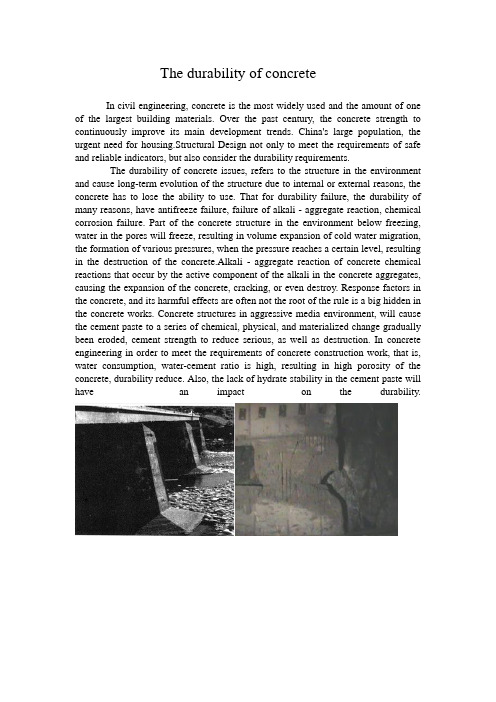
The durability of concreteIn civil engineering, concrete is the most widely used and the amount of one of the largest building materials. Over the past century, the concrete strength to continuously improve its main development trends. China's large population, the urgent need for housing.Structural Design not only to meet the requirements of safe and reliable indicators, but also consider the durability requirements.The durability of concrete issues, refers to the structure in the environment and cause long-term evolution of the structure due to internal or external reasons, the concrete has to lose the ability to use. That for durability failure, the durability of many reasons, have antifreeze failure, failure of alkali - aggregate reaction, chemical corrosion failure. Part of the concrete structure in the environment below freezing, water in the pores will freeze, resulting in volume expansion of cold water migration, the formation of various pressures, when the pressure reaches a certain level, resulting in the destruction of the concrete.Alkali - aggregate reaction of concrete chemical reactions that occur by the active component of the alkali in the concrete aggregates, causing the expansion of the concrete, cracking, or even destroy. Response factors in the concrete, and its harmful effects are often not the root of the rule is a big hidden in the concrete works. Concrete structures in aggressive media environment, will cause the cement paste to a series of chemical, physical, and materialized change gradually been eroded, cement strength to reduce serious, as well as destruction. In concrete engineering in order to meet the requirements of concrete construction work, that is, water consumption, water-cement ratio is high, resulting in high porosity of the concrete, durability reduce. Also, the lack of hydrate stability in the cement paste will have an impact on the durability.Therefore, to improve the durability of concrete, must reduce the porosity of the concrete, especially the capillary porosity, the most important method is to reduce the concrete mixing water. But if we simply reduce the amount of water, the concrete decreases, will lead to tamping forming a total of difficulties, the same result in the concrete structure is not dense, and even cellular and macroscopic defects such as, not only reduce the strength of concrete, and the durability of concrete also reduced. To improve the durability of concrete basic There are several ways: First, the strength of the material and engineering properties of cement cement is hardening formed by the condensation of the cement mortar, cement paste, once damaged, the durability of concrete is damaged, the choice of cement should pay attention to the specific performance of the varieties of cement, select alkali content, low heat of hydration, shrinkage of a small, heat resistance, water resistance, corrosion resistance, good frost resistance of cement and in the circumstances to choose . The strength of cement is not the sole criterion to determine the concrete strength and performance, such as lower grade cement can also be the preparation of high-grade concrete. Therefore, the project select the strength of cement at the same time, the need to consider the engineering performance, and sometimes, its engineering performance is more important than the strength. Aggregates and admixtures choice of the aggregate consideration should be given its alkali activity to prevent the harm caused by alkali-aggregate reaction, corrosion resistance and water absorption of the aggregate, reasonable choice of gradation, to improve the workability of the concrete mixture to increase concrete density; a large number of studies have shown that the doped fly ash, slag, silica fume, etc. the mixed caineng effectively improve the performance of the concrete, to improve the pore structure of concrete, filling the internal voids, and to increase the density, high-ash concrete can inhibition of alkali-aggregate reaction, and thus doped hybrid materials of concrete, is to improve the durability of concrete and effective measures. Development in recent years, high-performance concrete. Second, the rational design of concrete mix mix design meet the concrete strength, work should be considered to minimize the amount of cement and water consumption, lower heat of hydration, reduce shrinkage cracks, and to increase the density, and reasonable water reducer and air entraining agent, to improve the internal structure of concrete, mixed with a sufficient amount of mixture to improve concrete durability. Structural members shall use the environmental design of the concrete cover thickness, to prevent the outside media to penetrate the internal corrosion of reinforced. Node structural design of the structure should also be considered a component to the overallendurance capacity after partial damage. The structural design shall also control the crack width of concrete cracks. Third, the incorporation of an appropriate amount of admixtures, water-reducing agent such as: liquidity needed to ensure that concrete mixture at the same time, minimizing water consumption, reduce water-cement ratio, so that the total porosity of the concrete, in particular, the capillary porosity substantially reduced. 4, the incorporation of the hydrate stability, lack of efficient activity of mineral admixtures: ordinary Portland cement concrete, cement paste is another major factor in the concrete can not be super durable.To eliminate the structure of the concrete itself disruptive factor: In addition to concrete structural damage caused by environmental factors, some of the concrete itself, physical and chemical factors may also cause serious damage of the concrete structure, resulting in concrete failure. To ensure the strength of concrete: strength and durability is a different concept, but is closely related to the nature of links between them is based on the internal structure of the concrete with water-cement ratio, this factor is directly related.Concrete construction should also consider the durability of concrete mixing and maximize the use of the second mixing method, wrap the sand method, wrapped in the process of gravel law, improve the workability of the concrete mixing materials, water retention and improve the concrete strength, reduce water consumption; pouring mass concrete vibrators shall control the temperature of concrete cracks, shrinkage cracks, construction cracks, concrete pouring and vibrating system, to improve concrete density and impermeability, attention to the process of the surface after the concrete vibratorsand enhance the conservation, in order to reduce the concrete cracks. Concrete construction process control component appearance of cracks, construction cracks is essential and should strengthen the construction quality management, the special season of construction of concrete structures, there should be to take special measures.So, we want to develop the new concrete, such as high performance concrete.Therefore, to improve the durability of concrete is the inevitable trend of development of the concrete.。
Wittig反应介绍及研究状况
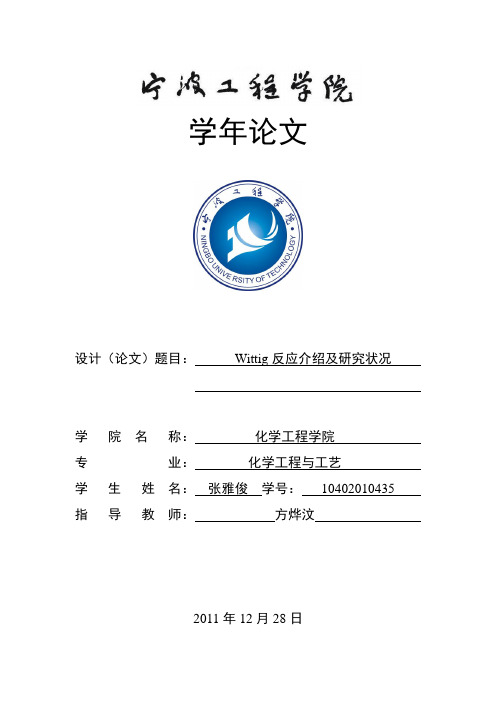
学年论文设计(论文)题目:Wittig反应介绍及研究状况学院名称:化学工程学院专业:化学工程与工艺学生姓名:张雅俊学号:*********** ***师:***2011年12月28日一、前言Wittig 反应这是极有价值的合成烯烃的一般方法。
根据中间体叶立德的稳定性可分为不稳定的叶立德的反应和稳定的叶立德的反应。
1.不稳定的叶立德的反应:当RR'CHBr 中,R和R'是氢原子或简单烷基,则烃基三苯基磷盐的α-H酸性较弱,需较强的碱(常用丁基锂或苯基锂)才能生成叶立德,刚生成的叶立德活性很高,是类似格氏试剂那样强的亲核试剂,能迅速地在温和条件下与醛或酮起反应给出加成物,反应不可逆。
加成物可自发分解给出烯烃。
2.稳定的叶立德的反应:当RR'CHBr中,R或R'是一个-M 基团(吸电子基团,如酯基),则烃基三苯基磷盐的去质子化可以在较弱的碱性条件下实现,并且产生的叶立德较稳定,可以分离,其活性相对较弱,一般需与亲电性较强的羰基反应。
本文主要介绍了Wittig反应的内容、反应机理以及在有机合成上的主要应用,并从Wittig-Homer反应、相转移催化Wittig反应和以水为溶剂的水相Wittig反应三方面来阐述Wittig反应的改进及其发展。
二、主题1953年,德国科学家G.Wittig发现了亚甲基化三苯基膦与二苯酮作用,得到几乎定量的偏二苯乙烯。
这个发现引起了有机化学家的重视,并将其命名为Wittig反应[1]。
由于该反应产率较高,条件温和,具有高度的位置选择性,并且在合成最新系列的高级的不同种类的精细有机化学品,如各种昆虫信息素、绿色除菌及除草农药、乙烷类液晶、新型医药及其中间体、重要的抗生素、有机发光材料和光导体等,都得到了众多的应用,因此越来越受到化学家的重视。
目前,该反应已经成为合成烯烃最重要也最普遍的反应。
1 Wittig反应简介Wittig反应是由叶立德与羰基化合物缩合生成烯烃的反应,是有机化学中最要和最有用的反应之一。
experiment英文作文
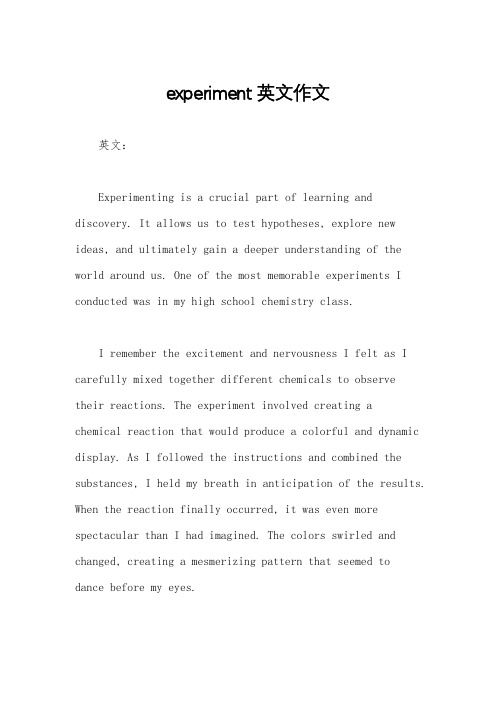
experiment英文作文英文:Experimenting is a crucial part of learning and discovery. It allows us to test hypotheses, explore new ideas, and ultimately gain a deeper understanding of the world around us. One of the most memorable experiments I conducted was in my high school chemistry class.I remember the excitement and nervousness I felt as I carefully mixed together different chemicals to observetheir reactions. The experiment involved creating achemical reaction that would produce a colorful and dynamic display. As I followed the instructions and combined the substances, I held my breath in anticipation of the results. When the reaction finally occurred, it was even more spectacular than I had imagined. The colors swirled and changed, creating a mesmerizing pattern that seemed todance before my eyes.This hands-on experience not only solidified my understanding of chemical reactions, but it also sparked a deeper interest in the field of chemistry. It showed me the power of experimentation in bringing scientific concepts to life and making them more tangible and exciting. Through this experiment, I learned that sometimes the most valuable lessons come from stepping out of our comfort zones and trying something new.中文:实验是学习和发现的重要组成部分。
化学反应工程英文课件Chapter 5
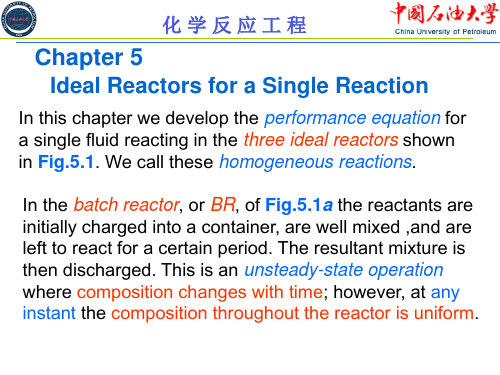
XA 0 XA dXA dXA CA0 0 ( r )(1 X ) ( rA )V0 (1 A XA ) A A A
(5)
化学反应工程
In one form or another, Eqs.2 to 5 have all been encountered in Chapter 3. They are applicable to both isothermal and nonisothermal operations. For the latter the variation of rate with temperature, and the variation of temperature with conversion, must be known before solution is possible. Figure 5.2 is a graphical representation of two of these equations.
accumulati on of A, moles/time
dNA d [ N A0 (1 X A )] dX A N A0 dt dt dt
化学反应工程
By replacing these two terms in Eq.1, we obtain
( rA )V N A 0
rate of loss of reactant A or within reactor due to chemical reaction rate of accumudation of reactant A within the reactor (1)
In the treatment to follow it should be understood that the term V, called the reactor volume, really refers to the volume of fluid in the reactor. When this differs from the internal volume of reactor, then Vr ‘designates(指明,任命) the internal volume of reactor while V designates the volume of reacting fluid. For example, in solid catalyzed reactors with voidage (空 隙率) we have V = Vr For homogeneous systems, however, we usually use the term V alone.
反应动力学 英文
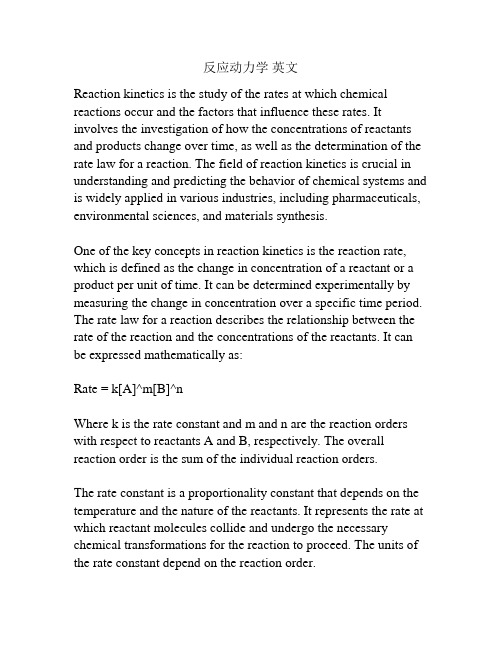
反应动力学英文Reaction kinetics is the study of the rates at which chemical reactions occur and the factors that influence these rates. It involves the investigation of how the concentrations of reactants and products change over time, as well as the determination of the rate law for a reaction. The field of reaction kinetics is crucial in understanding and predicting the behavior of chemical systems and is widely applied in various industries, including pharmaceuticals, environmental sciences, and materials synthesis.One of the key concepts in reaction kinetics is the reaction rate, which is defined as the change in concentration of a reactant or a product per unit of time. It can be determined experimentally by measuring the change in concentration over a specific time period. The rate law for a reaction describes the relationship between the rate of the reaction and the concentrations of the reactants. It can be expressed mathematically as:Rate = k[A]^m[B]^nWhere k is the rate constant and m and n are the reaction orders with respect to reactants A and B, respectively. The overall reaction order is the sum of the individual reaction orders.The rate constant is a proportionality constant that depends on the temperature and the nature of the reactants. It represents the rate at which reactant molecules collide and undergo the necessary chemical transformations for the reaction to proceed. The units of the rate constant depend on the reaction order.Factors that influence reaction rates include temperature, concentration, catalysts, and surface area. According to the collision theory, an increase in temperature leads to higher molecular kinetic energy, resulting in increased molecular collisions and, therefore, an increased reaction rate. Similarly, an increase in reactant concentration increases the frequency of molecular collisions and, consequently, the reaction rate.Catalysts are substances that increase the rate of a chemical reaction without being consumed during the process. They provide an alternative reaction pathway with lower activation energy, allowing for more successful molecular collisions and a higher reaction rate. Surface area is another important factor, especially in heterogeneous reactions, where reactants are initially present in different phases. Increasing the surface area of a solid reactant increases the number of accessible reactive sites, enhancing the frequency of molecular collisions and, hence, the reaction rate.Reaction kinetics can be described using different mathematical models, such as the integrated rate laws and the Arrhenius equation. Integrated rate laws represent the relationship between concentration and time for a reaction of a specific order. The Arrhenius equation relates the rate constant with temperature and activation energy. It can be expressed as:k = A * exp(-Ea/RT)Where k is the rate constant, A is the pre-exponential factor, Ea is the activation energy, R is the ideal gas constant, and T is the temperature in Kelvin.In conclusion, reaction kinetics is a fundamental field in chemistry that studies the rates at which chemical reactions occur. It involves the determination of rate laws, rate constants, and the factors that affect reaction rates. Understanding reaction kinetics is essential for predicting and controlling the behavior of chemical systems and is widely applicable in numerous scientific and industrial settings.。
化学反应英文结论
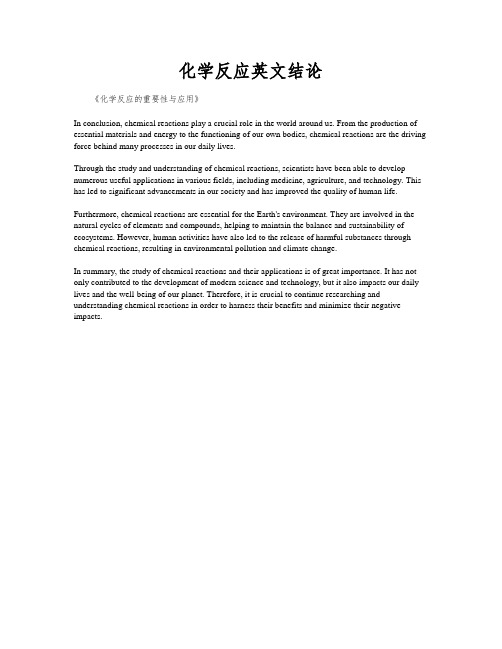
化学反应英文结论《化学反应的重要性与应用》In conclusion, chemical reactions play a crucial role in the world around us. From the production of essential materials and energy to the functioning of our own bodies, chemical reactions are the driving force behind many processes in our daily lives.Through the study and understanding of chemical reactions, scientists have been able to develop numerous useful applications in various fields, including medicine, agriculture, and technology. This has led to significant advancements in our society and has improved the quality of human life.Furthermore, chemical reactions are essential for the Earth's environment. They are involved in the natural cycles of elements and compounds, helping to maintain the balance and sustainability of ecosystems. However, human activities have also led to the release of harmful substances through chemical reactions, resulting in environmental pollution and climate change.In summary, the study of chemical reactions and their applications is of great importance. It has not only contributed to the development of modern science and technology, but it also impacts our daily lives and the well-being of our planet. Therefore, it is crucial to continue researching and understanding chemical reactions in order to harness their benefits and minimize their negative impacts.。
土木工程混凝土论文中英文资料外文翻译文献

土木工程混凝土论文中英文资料外文翻译文献外文资料STUDIES ON IMPACT STRENGTH OF CONCRETESUBJECTED TO SUSTAINEDELEVATED TEMPERATUREConcrete has a remarkable fire resisting properties. Damage in concrete due to fire depends on a great extent on the intensity and duration of fire. Spalling cracking during heating are common concrete behaviour observed in the investigation of the fire affected structures. Plenty of literature is available on the studies of concrete based on time temperature cures. In power, oil sectorsand nuclear reactors concrete is exposed to high temperature for considerable period of time. These effects can be reckoned as exposure to sustained elevated temperature. The sustained elevated temperature may be varying from a few hours to a number of years depending upon practical condition of exposures. The knowledge on properties under such conditions is also of prime importance apart from the structures subjected to high intensity fire. Impact studies of structure subjected to sustained elevated temperature becomes more important as it involves sensitive structures which is more prone to attacks and accidents. In this paper impact studies on concrete subjected to sustained elevated temperature has been discussed. Experiments have been conducted on 180 specimens along with 180 companion cube specimens. The temperatures of 100°C, 200°C and 300°C for a duration of exposure of 2 hours 4 hours and 6 hours has been considered in the experiments. The results are logically analyzed and concluded.1. INTRODUCTIONThe remarkable property of concrete to resist the fire reduces the damage in a concrete structure whenever there is an accidental fire. In most of the cases the concrete remains intact with minor damages only. The reason being low thermal conductivity of concrete at higher temperatures and hence limiting the depth of penetration of firedamage. But when the concrete is subjected to high temperature for long duration the deterioration of concrete takes place. Hence it is essential to understand the strength and deformation characteristics of concrete subjected to temperature for long duration. In this paper an attempt has been made to study the variation in Impact Strength of concrete when subjected to a temperature range 100oC, 200oC and 300oC sustained for a period of 2 hrs, 4 hrs and 6 hrs.The review of the literature shows that a lot of research work [1 – 3] has taken place on the effect of elevated temperature on concrete. All these studies are based on time –temperature curves. Hence an attempt has been made to study the effect of sustained elevated temperature on impact strength of concrete and the results are compared with the compressive strength. The experimental programme has been planned for unstressed residual strength test based on the available facilities. Residual strength is the strength of heated and subsequently cooled concrete specimens expressed as percentage of the strength of unheated specimens.2. EXPERIMENTAL INVESTIGATION2.1. TEST SPECIMEN AND MATERIALSA total of 180 specimens were tested in the present study along with 180 companion cubes. An electric oven capable of reaching a maximum temperature of 300oC has been used for investigation. Fine and coarse aggregates conforming to IS383 has been used to prepare the specimen with mix proportions M1 = 1:2.1:3.95 w/c = 0.58, M2 = 1:1.15:3.56 w/c = 0.53, M3 = 1:0.8:2.4 w/c = 0.4.2.2 TEST VARIABLESThe effects of the following variables were studied.2.2.1 Size sSize of Impact Strength Test Specimen was 150 mm dial and 64 mm thickness and size of companion cube 150 x 150 x 150 mm.2.2.2 Maximum TemperatureIn addition to room temperature, the effect of three different temperatures (100oC, 200oC and 300oC) on the compressive strength was investigated.2.2.3 Exposure Time at Maximum TemperatureThree different exposure times were used to investigate the influence of heat on compressive strength; they are 2 hrs, 4 hrs and 6 hrs.2.2.4 Cooling MethodSpecimens were cooled in air to room temperature.3. TEST PROCEDUREAll the specimens were cast in steel moulds as per IS516 and each layer was compacted. Specimens were then kept in their moulds for 24 hours after which they were decoupled and placed into a curing tank until 28 days. After which the specimens were removed and were allowed to dry in room temperature. These specimens were kept in the oven and the required target temperature was set. Depending on the number of specimen kept inside the oven the time taken to reach the steady state was found to vary. After the steady state was reached the specimens were subjected to predetermined steady duration at the end of which the specimens are cooled to room temperature and tested.ACI drop weight impact strength test was adopted. This is the simplest method for evaluating impact resistance of concrete. The size of the specimen is 150 mm dial and 64 mm thickness. The disc specimens were prepared using steel moulds cured and heated and cooled as. This consists of a standard manually operated 4.54 kg hammer with 457 mm drop. A 64 mm hardened steel ball and a flat base plate with positioning bracket and lugs. The specimen is placed between the four guides pieces (lugs) located 4.8 mm away from the sample. A frame (positioning bracket) is then built in order to target the steel ball at the centre of concrete disc. The disc is coated at the bottom with a thin layer of petroleum jelly or heavy grease to reduce the friction between the specimen and base plate. The bottom part of the hammer unit was placed with its base upon the steel ball and the load was applied by dropping weight repeatedly. The loading was continued until the disc failed and opened up such that it touched three of the four positioning lugs. The number of blows that caused this condition is recorded as the failure strength. The companion cubes were tested for cube compression strength (fake).4. ANALYSIS AND RESULTS4.1 RESIDUAL COMPRESSIVE STRENGTH VS. TEMPERATUREFrom Table 1, at 100°C sustained elevated temperature it is seen that the residual strength of air cooled specimens of mixes M1, M2 and M3 has increased in strength 114% for M1 mix, 109% for M2 mix and 111% for M3 mix for 6 hours duration of exposure. When the sustained elevated temperature is to 200°C for air cooled specimens there is a decrease in strength up to 910% approximately for M1 mix for a duration of 6 hours, but in case of M2 mix it is 82% and for M3 mix it is 63% maximum for 6 hours duration of exposure. When the concrete mixes M1, M2 and M3 are exposed to 300°C sustained temperature there is a reduction in strength up to 78% for M1 mix for 6 hour duration of exposure.4.2 RESIDUAL COMPRESSIVE STRENGTH VS DURATION OF EXPOSUREFrom Table 1, result shows that heating up to 100°C for 2 hours and 4 hours, the residual strength of mix M1 has decreased where as the residual strength of mix M2 and M3 has increased. The residual strength is further increased for 6 hours duration of exposure in all the three mixes M1, M2 and M3 even beyond the strength at room temperature. When the specimens of mixes M1, M2 and M3 are exposed to 200°C for 2,4 and 6 hours of duration, it is observed that the residual strength has decreased below the room temperature and has reached 92% for M1 mix, 82 and 73% for M2 and M3 mix respectively. Concrete cubes of mixes M1, M2 and M3 when subjected to 300°C temperature for 2,4 and 6 hours the residual strength for mix M1 reduces to 92% for 2 hours up to 78% for six hours duration of exposure, for M2 mix 90% for 2 hours duration of exposure up to 76% for six hour duration of exposure, for M3 mix 88% up to 68% between 2 and 6 hours of duration of exposure.5. IMPACT STRENGTH OF CONCRETE5.1 RESIDUAL IMPACT STRENGTH VS TEMPERATUREFrom the table 1, it can be observed that for the sustained elevated temperature of 100°C the residual impact strength of all the specimens reduces and vary between 20 and 50% for mix M1, 15 to 40% for mix M2 and M3. When the sustained elevated temperature is 200°C the residual impact strength of all the mixes further decreases. The reduction is around 60-70% for mix M1, 55 to 65% for M2 and M3 mix. When the sustained elevated temperature is 300°C it is observed that the residual impact strength reduces further and vary between 85 and 70% for mix M1 and 85 to 90% for mix M2 and mix M3.5.2 RESIDUAL IMPACT STRENGTH VS DURATION OF EXPOSUREFrom the Table 1 and Figures 1 to 3, it can be observed that there is a reduction in impact strength when the sustained elevated temperature is 100°C for 2 hrs, 4 hrs and 6 hrs, and its range is 15 to 50% for all the mixes M1, M2 and M3. The influence of duration of exposure is higher for mix M1 which decreases more rapidly as compared to mix M2 and mix M3 for the same duration of exposure. When the specimens are subjected to sustained elevated temperature of 200°C for 2,4 and 6 hour of duration, further reduction in residual impact strength is observed as compared to at 100°C. The reduction is in the range of 55-70% for all the mixes. The six hour duration of exposure has a greater influence on the residual impact strength of concrete. When the sustained elevated temperature is 300°C for 2,4 and 6 hours duration of exposure the residualimpact strength reduces. It can be seen that both temperature and duration of exposure have a very high influence on the residual impact strength of concrete which shows a reduction up to 90% approximately for all the mixes.6. CONCLUSIONThe compressive strength of concrete increases at 100oC when exposed to sustained elevated temperature. The compressive strength of concrete decreases when exposed to 200°C and 300°C from 10 to 30% for 6 hours of exposure. Residual impact strength reduces irrespective of temperature and duration. Residual impact strength decreases at a higher rate of 20% to 85% as compared to compressive strength between 15% and 30 % when subjected to sustained elevated temperature. The impact strength reduces at a higher rate as compared to compressive strength when subjected to sustained elevated temperature.混凝土受持续高温影响的强度的研究混凝土具有显着的耐火性能。
《化学反应工程》课程双语教学的实践与认识
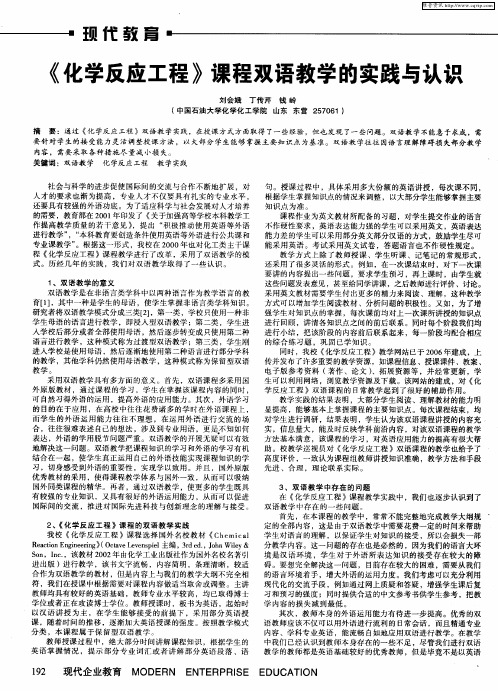
坝 代 教 胄
《 化学反应工程 》课程双语教学的实践与认识
刘会 娥 丁传 芹 钱 岭 ( 国石油 大学 化学 化 工学 院 山东 东 营 2 7 6 中 5 0 1)
摘 要 :通 过 《 学反 应 工程 》双语 教 学 实践 ,在授 课 方 式 方 面取得 了一 些 经验 ,但也 发 现 了一 些 问题 。双语 教 学 不 能急 于 求成 ,需 化 要 针 对 学生 的接 受 能 力灵 活 调 整授 课 方 法 , 以 大部 分 学 生 能 够 掌握 主 要 知 识 点 为基 准 。 双 语教 学往 往 因语 言 理 解 障碍 损 失 部 分教 学 内容 , 需要 采 取 各 种措 施 尽 量减 小损 失 。 关键词 :双语教学 化学反应工程 教学实践 社 会 与科 学 的进 步 促 使 国 际 间的 交 流与 合作 不断 地 扩展 ,对 人才 的要求 也渐 为提高 ,专业人才不仅要具有扎实的专业水平 ,
还 要具 有较 强 的外 语 功底 。为 了适 应 科 学与 社 会 发展 对 人 才培 养 的需要 ,教育 部在 2 0 年 印发 了 《 于加 强高 等 学校 本科 教学 工 01 关 作 提 高 教学 质量 的若 干意 见 》 ,提 出 “ 极 推 动 使用 英 语 等 外 语 积 进 行教 学 ” 本科 教 育 要创 造 条件 使 用 英语 等 外语 进 行公 共 课 和 ,“ 专 业课 教 学 ” 。根据 这 一形 式 ,我校 在 2 0 年 也 对化 工类 主干 课 00
程 《 化学反应工程 》课程教学进行了改革 ,采用了双语教学的模
式 。历 经几 年 的实 践 ,我 们 对 双 语 教 学取 得 了一 些 认 识 。 1 、双 语 教 学 的意 义 双语 教 学 是在 非 语 言类 学 科 中以两 种 语 言作 为教 学语 言的 教 育 【] 1 ,其 中一 种 是 学 生 的母 语 ,使 学 生 掌 握非 语 言 类 学科 知 识 。 研究 者 将 双语 教学 模 式分 成 三类 【] 2 ,第 一类 ,学 校 只使用 一 种 非 学 生母 语 的语 言进行 教 学 ,即浸 入 型双 语 教 学 ;第 二 类 ,学 生 进 入学 校 后 部分 或 者 全部 使 用母 语 ,然后 逐 步 转变 成 只 使用 第 二 种 语 言进 行 教学 ,这 种模 式 称 为过 渡 型双 语 教 学 ;第 三类 ,学 生 刚 进 入 学 校 是使 用 母语 ,然 后逐 渐 地 使用 第 二 种语 言 进行 部 分 学科 的教 学 ,其他 学 科 仍然 使 用母 语 教 学 ,这 种模 式 称 为 保 留型 双语 教学。 采 用 双语 教学 具 有 多方 面 的 意义 。首先 ,双 语课 程 多 采 用 国 外 原 版 教 材 ,通 过 课程 的学 习 ,学 生 在 掌 握 该课 程 内容 的同 时 , 可 自然 习得 外 语 的运 用 ,提 高 外 语 的应 用 能 力 。其 次 ,外 语 学 习 的 目的在 于 应 用 ,在 高 校 中往 往 花 费 诸 多 的学 时在 外 语 课 程 上 , 而 学生 的 外 语 运 用 能 力 往 往 不 理想 ,在 运 用 外 语 进 行 交及到专业用语 ,更是不知如何
化学反应工程(ChemicalReactionEngineering)
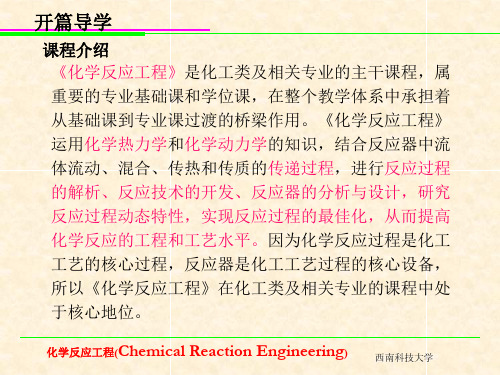
§1-1化学反应工程
第一节 化学反应工程 一、化学反应工程的研究对象
化学反应工程是化学工程学科的一个重要分支,主要包括 两个方面的内容,即反应动力学和反应器设计分析。
反应动力学--研究化学反应进行的机理和速率,以获得工 业反应器设计与操作所需的动力学知识和信息,如反应模式、 速率方程及反应活化能等。其中速率方程可表示为:
化学反应工程(Chemical Reaction Engineering) 西南科技大学
§1-1化学反应工程
例如: so2 o2 为钒 一 气固催s化o反3 应
化学反应工程(Chemical Reaction Engineering) 西南科技大学
§1-1化学反应工程
三、反应过程的举例
化学反应工程(Chemical Reaction Engineering) 西南科技大学
§1-1化学反应工程
无论对于放热过程,还是吸热过程,催化剂与 反应物气体存在温差。 就整个反应器而言,如反应器内的浓度和温度 随位置变化,需将化学反应与传递现象综合起 来考虑。
四、化学反应工程作用
对于化学产品和加工过程的开发、反应器 的设计放大起着重要的作用。运用化学反应工程 知识可以: 提高反应器的放大倍数,减少试验和开发周期。
Chapter Ⅰ绪 论 Chapter Ⅰ绪 论 Chapter 1 Introduction
§1-1 化学反应工程 §1-2 转化率、收率和选择性 §1-3 化学反应器的类型 §1-4 反应器的操作方式 §1-5 反应器的设计与基本过程 §1-6 工业反应器的放大
化学反应工程(Chemical Reaction Engineering) 西南科技大学
化学反应原理英语
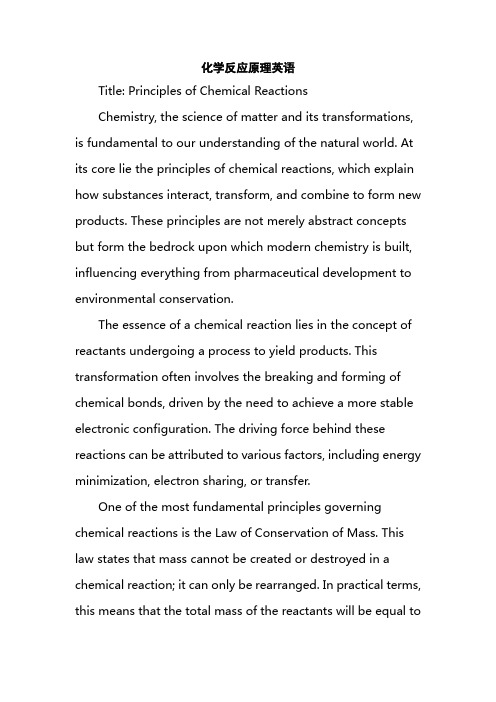
化学反应原理英语Title: Principles of Chemical ReactionsChemistry, the science of matter and its transformations, is fundamental to our understanding of the natural world. At its core lie the principles of chemical reactions, which explain how substances interact, transform, and combine to form new products. These principles are not merely abstract concepts but form the bedrock upon which modern chemistry is built, influencing everything from pharmaceutical development to environmental conservation.The essence of a chemical reaction lies in the concept of reactants undergoing a process to yield products. This transformation often involves the breaking and forming of chemical bonds, driven by the need to achieve a more stable electronic configuration. The driving force behind these reactions can be attributed to various factors, including energy minimization, electron sharing, or transfer.One of the most fundamental principles governing chemical reactions is the Law of Conservation of Mass. This law states that mass cannot be created or destroyed in a chemical reaction; it can only be rearranged. In practical terms, this means that the total mass of the reactants will be equal tothe total mass of the products. This principle underscores the importance of stoichiometry, which allows chemists to predict the quantities of reactants and products in a reaction based on the balanced chemical equation.Another crucial principle is the Concept of Limiting Reagent. In any given reaction, the reactant that runs out first determines the maximum amount of product that can be formed. This concept is essential for optimizing reactions in industrial processes, where efficiency and cost-effectiveness are paramount.Energy plays a significant role in chemical reactions, as dictated by the Principle of Energy Change. Endothermic reactions absorb energy from their surroundings, while exothermic reactions release energy into them. This energy exchange is critical in determining the spontaneity and feasibility of a reaction. For instance, combustion reactions are typically exothermic, releasing heat and light, which is why they are easily ignited and sustained.Chemical reactions also adhere to the Principle of Rate and Equilibrium. The rate at which a reaction proceeds depends on factors such as concentration, temperature, and the presence of catalysts. Some reactions reach an equilibriumstate, where the rates of the forward and reverse reactions are equal, resulting in a mixture of reactants and products that remains constant over time. Understanding these dynamics is crucial for controlling reactions to favor the desired outcome.Furthermore, the Principle of Chemical Kinetics provides insights into how fast a reaction occurs and the mechanisms by which reactants are converted into products. This includes studying activation energies, intermediate steps, and the effects of temperature and pressure on reaction rates.Finally, the Principle of Le Chatelier's tells us that if a change is applied to a system in equilibrium, the system will adjust itself to counteract that change. This principle helps in predicting the direction in which a reaction will shift in response to changes in concentration, temperature, or pressure.In conclusion, the principles of chemical reactions form the foundation of chemistry, guiding scientists and engineers in their quest to understand and manipulate the world around them. From the subtle dance of atoms during a reaction to the grand applications in industry and medicine, these principles illuminate the intricate beauty of chemical transformations.。
化学英文文章

化学英文文章当涉及化学的英文文章时,可以根据具体的主题来搜索相关文章。
以下是一个化学方面的英文文章示例,主题为"The Role of Catalysts in Chemical Reactions"(催化剂在化学反应中的作用):Title: The Crucial Role of Catalysts in Chemical ReactionsAbstract:Chemical reactions play a pivotal role in various industrial processes and everyday life. One key factor influencing the rate and efficiency of these reactions is the use of catalysts. This article explores the fundamental principles of catalysis and delves into the diverse applications of catalysts across different chemical processes.Introduction:Catalysts are substances that accelerate chemical reactions by providing an alternative reaction pathway with lower activation energy. This property makes them indispensable in numerous industrial processes, including the production of fuels, pharmaceuticals, and polymers.Catalysis Mechanisms:The article discusses the mechanisms through which catalysts operate, such as providing a surface for reactants to bind, facilitating the breaking of chemical bonds, or stabilizing intermediate reaction states. Examples of common catalysts, including transition metals and enzymes, are highlighted.Industrial Applications:A significant portion of the article is dedicated to exploring how catalysts are employed in industrial settings. Case studies include the catalytic cracking of hydrocarbons in petroleum refining, the synthesis of ammonia in the Haber-Bosch process, and the role of enzymes in food processing.Environmental Impact:The environmental implications of catalysis are also addressed. The article examines how catalysts contribute to reducing energy consumption and minimizing the production of undesirable by-products, aligning with the principles of green chemistry.Current Research and Future Prospects:The concluding sections provide insights into ongoing research in catalysis, including the development of novel catalysts and the exploration of catalytic processes in emerging fields such as sustainable energy and nanotechnology. The article concludes by discussing the potential future advancements and challenges in the field of catalysis.Conclusion:In summary, this article sheds light on the indispensable role of catalysts in chemical reactions. From fundamental principles to practical applications, catalysts significantly impact the efficiency, sustainability, and economic viability of diverse chemical processes.注意,这只是一个示例,可以根据感兴趣的具体化学主题调整文章的内容。
化工原理有关的英文文章

化工原理有关的英文文章The Important Role of Chemical Engineering Principles in Modern SocietyChemical engineering principles play a vital role in modern society. This field of engineering combines knowledge from chemistry, physics, biology, and mathematics to design, develop, and optimize industrial processes that involve the transformation of raw materials into useful products.One of the key areas where chemical engineering principles are applied is in the production of chemicals. Chemical engineers design and operate processes for the manufacture of various chemical products such as fertilizers, pharmaceuticals, plastics, and specialty chemicals. They must consider factors such as reaction kinetics, heat transfer, mass transfer, and separation techniques to ensure efficient and safe production.Another important application of chemical engineering principles is in the field of energy production. Chemical engineers are involved in the design and operation of processes for the production of fuels such as gasoline, diesel, and natural gas. They also work on improving the efficiency of energy conversion processes, such as power plants and fuelcells, by optimizing chemical reactions and heat transfer.Environmental protection is another area where chemical engineering principles are critical. Chemical engineers are tasked with developing and implementing processes to minimize the impact of industrial activities on the environment. They work on reducing emissions, improving waste management, and developing sustainable processes and materials.Moreover, chemical engineering principles are applied in the field of food and beverage production. Chemical engineers work on optimizing processes for the manufacturing of food products, ensuring their safety and quality. They also develop new techniques for food preservation and packaging to extend shelf life and minimize food waste.In conclusion, chemical engineering principles are integral to various industries and have a significant impact on modern society. From the production of chemicals to energy generation, environmental protection, and food production, chemical engineers play a crucial role in ensuring efficient and sustainable processes. Through their expertise, they contribute to the development of new and improved products, processes,and technologies that drive societal progress.。
反应工程心得(精选5篇)

反应工程心得(精选5篇)反应工程心得篇1标题:反应工程学习之路:从理论到实践的深度体验反应工程是工程学领域中一门重要的学科,它涵盖了化学反应工程、生物反应工程和热力学等多个分支。
作为一名工程专业的学生,我有幸参与了一个反应工程的研究项目,从而对这一领域有了更深入的理解。
反应工程的核心在于理解并优化化学反应,使之在生产过程中更高效、更环保。
这一领域涉及到的实际问题非常广泛,从合成新材料,到处理废弃物,再到生产清洁能源,反应工程在其中都起到了关键作用。
在我们的研究项目中,我们的任务是设计一个新型的反应过程,用于提高石油裂解反应的效率。
石油裂解是一种将石油原料转化为气体燃料的过程,但传统的石油裂解反应存在着能源消耗大、产物分离困难等问题。
我们的设计目标是通过优化反应条件,提高反应效率,同时减少副反应的产生。
为了解决这个问题,我们首先进行了理论分析,明确了反应的温度、压力、反应时间等参数对反应效率的影响。
然后,我们在实验室中进行了实验,通过调整这些参数,找到了一种新的反应条件。
最后,我们分析了实验数据,验证了我们的理论模型的正确性。
这次经历让我深刻地感受到了反应工程的重要性。
反应工程不仅仅是关于反应的速度和产物的问题,更是关于如何最优地利用资源,最小化环境影响,同时最大化生产效率的问题。
这需要我们对化学、物理、数学等多个学科的知识都有深入的理解和应用能力。
同时,我也认识到团队协作的重要性。
在这个项目中,我们的团队成员各自负责不同的任务,如理论分析、实验操作和数据分析等。
每个人的贡献都对项目的成功至关重要。
最后,我明白了理论和实践的结合对于反应工程的重要性。
理论可以帮助我们理解反应的本质,但只有通过实验,我们才能找到实际应用中的最优条件。
反应工程心得篇2反应工程是一门致力于研究化学反应的工程学科,它涵盖了从基础理论到实践应用的广泛领域。
下面是我在学习反应工程时的一些心得体会:1.理解反应工程的基础理论知识是至关重要的。
关于工程的英文作文
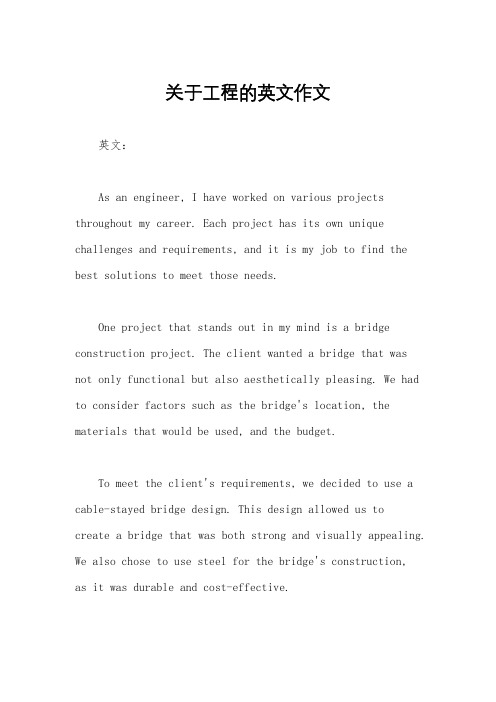
关于工程的英文作文英文:As an engineer, I have worked on various projects throughout my career. Each project has its own unique challenges and requirements, and it is my job to find the best solutions to meet those needs.One project that stands out in my mind is a bridge construction project. The client wanted a bridge that was not only functional but also aesthetically pleasing. We had to consider factors such as the bridge's location, the materials that would be used, and the budget.To meet the client's requirements, we decided to use a cable-stayed bridge design. This design allowed us tocreate a bridge that was both strong and visually appealing. We also chose to use steel for the bridge's construction,as it was durable and cost-effective.Throughout the project, we faced various challenges, such as dealing with unexpected weather conditions and managing the construction schedule. However, we were able to overcome these challenges by working closely with the client and our team of engineers and contractors.In the end, the bridge was completed on time and within budget. The client was thrilled with the end result, and the bridge has become a landmark in the community.Overall, working on this project taught me the importance of communication, collaboration, and problem-solving skills in engineering. It also showed me the impact that a well-designed and executed project can have on a community.中文:作为一名工程师,我在职业生涯中参与了各种各样的项目。
英语描述解决一个工程问题作文
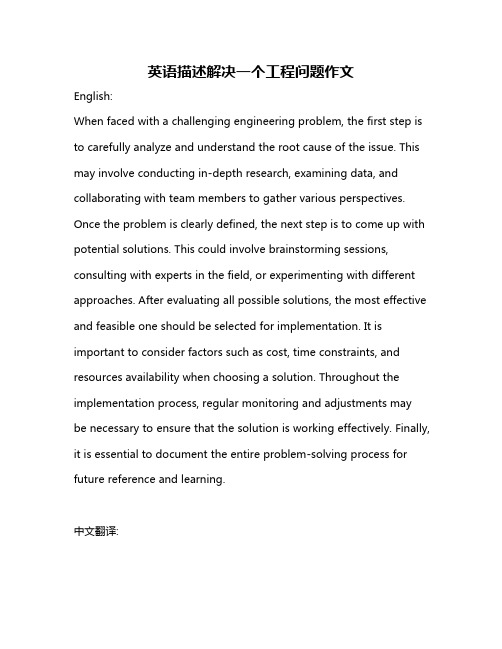
英语描述解决一个工程问题作文English:When faced with a challenging engineering problem, the first step is to carefully analyze and understand the root cause of the issue. This may involve conducting in-depth research, examining data, and collaborating with team members to gather various perspectives. Once the problem is clearly defined, the next step is to come up with potential solutions. This could involve brainstorming sessions, consulting with experts in the field, or experimenting with different approaches. After evaluating all possible solutions, the most effective and feasible one should be selected for implementation. It is important to consider factors such as cost, time constraints, and resources availability when choosing a solution. Throughout the implementation process, regular monitoring and adjustments may be necessary to ensure that the solution is working effectively. Finally, it is essential to document the entire problem-solving process for future reference and learning.中文翻译:面对一个具有挑战性的工程问题,第一步是仔细分析和了解问题的根本原因。
关于化学实验的英文作文

关于化学实验的英文作文英文:Chemistry experiments have always been a fascinating part of my academic journey. The hands-on experience and the thrill of seeing chemical reactions take place right in front of my eyes have always been a source of excitementfor me. One of the most memorable experiments I have conducted was the synthesis of aspirin in the organic chemistry lab.The experiment involved several steps, including the esterification of salicylic acid with acetic anhydride, followed by the hydrolysis of the ester and the isolation of the aspirin product. It was a complex process that required precision and careful attention to detail. I remember being nervous about handling the chemicals and making sure that I followed the procedure correctly.As I mixed the reagents and observed the changes in thereaction mixture, I couldn't help but feel a sense of anticipation. When the aspirin crystals began to form, it was a moment of triumph for me. Seeing the white, powdery crystals at the bottom of the flask was incredibly satisfying, knowing that I had successfully synthesized a common household medication.The experience taught me the importance of following instructions and understanding the principles behind the reactions. It also highlighted the significance of safety measures in the laboratory. I learned to wear protective gear, handle the chemicals with care, and clean up the workspace diligently after the experiment.Overall, the synthesis of aspirin was a valuable learning experience that not only deepened my understanding of organic chemistry but also instilled in me a sense of responsibility when conducting experiments. It was a reminder that chemistry is not just about mixing chemicals in a lab, but about applying knowledge and skills to achieve a desired outcome.中文:化学实验一直是我学术生涯中令人着迷的一部分。
英语描述解决一个工程问题作文
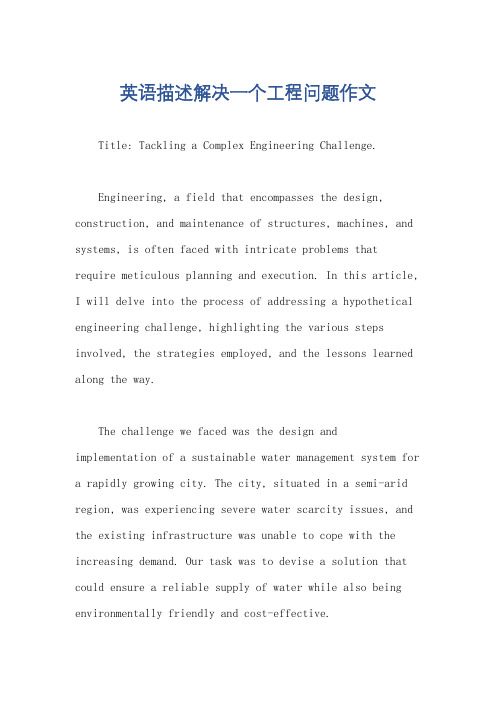
英语描述解决一个工程问题作文Title: Tackling a Complex Engineering Challenge.Engineering, a field that encompasses the design, construction, and maintenance of structures, machines, and systems, is often faced with intricate problems that require meticulous planning and execution. In this article, I will delve into the process of addressing a hypothetical engineering challenge, highlighting the various steps involved, the strategies employed, and the lessons learned along the way.The challenge we faced was the design and implementation of a sustainable water management system for a rapidly growing city. The city, situated in a semi-arid region, was experiencing severe water scarcity issues, and the existing infrastructure was unable to cope with the increasing demand. Our task was to devise a solution that could ensure a reliable supply of water while also being environmentally friendly and cost-effective.The first step in addressing this challenge was to conduct a thorough analysis of the existing situation. We gathered data on the city's water consumption patterns, supply sources, and infrastructure capabilities. We also conducted a detailed assessment of the environmental impact of the current water management practices. This initial research phase was crucial as it provided us with a clear understanding of the problem and helped us identify the key areas that needed attention.Based on our findings, we proposed a comprehensivewater management system that encompassed several components. One of the key features of our solution was the integration of water conservation techniques such as rainwater harvesting and graywater recycling. We also suggested the installation of smart meters to monitor water usage and identify areas of excessive consumption. Additionally, we proposed the development of new water sources, such as desalination plants and groundwater recharge facilities, to augment the city's water supply.The implementation phase was a challenging task that required close collaboration between various stakeholders, including government agencies, private sector partners, and the local community. We worked closely with the city authorities to ensure that the project aligned with their long-term planning goals. We also involved local experts and community members in the decision-making process, ensuring that their needs and concerns were addressed.During the implementation phase, we encountered several challenges, including technical difficulties, budget constraints, and community resistance. We addressed these issues by conducting regular meetings with stakeholders, seeking their feedback, and making necessary adjustments to the plan. We also leveraged innovative technologies and partnerships to overcome technical barriers and reduce costs.Upon completion of the project, we conducted a thorough evaluation to assess its impact and identify areas for improvement. We found that the new water management system had significantly improved the city's water supplyreliability, reduced water waste, and enhanced environmental sustainability. The smart meters had helped residents become more aware of their water usage patterns, leading to a reduction in overall consumption.In conclusion, addressing complex engineering challenges requires a multifaceted approach that encompasses thorough analysis, innovative solutions, and stakeholder collaboration. The successful implementation of our water management system in the rapidly growing city demonstrates the power of engineering in addressing pressing societal issues. Through continuous learning and improvement, we can ensure that engineering continues to play a pivotal role in building a sustainable and prosperous future.。
英语描述解决一个工程问题作文
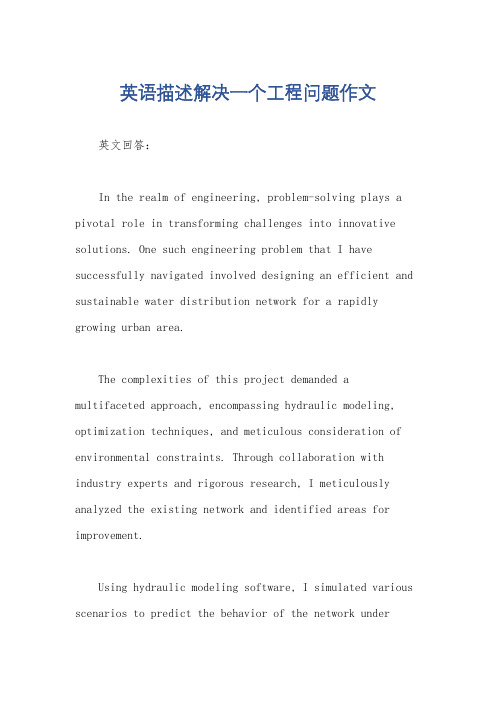
英语描述解决一个工程问题作文英文回答:In the realm of engineering, problem-solving plays a pivotal role in transforming challenges into innovative solutions. One such engineering problem that I have successfully navigated involved designing an efficient and sustainable water distribution network for a rapidly growing urban area.The complexities of this project demanded a multifaceted approach, encompassing hydraulic modeling, optimization techniques, and meticulous consideration of environmental constraints. Through collaboration with industry experts and rigorous research, I meticulously analyzed the existing network and identified areas for improvement.Using hydraulic modeling software, I simulated various scenarios to predict the behavior of the network underdifferent demand patterns and system configurations. Thisin-depth analysis allowed me to identify bottlenecks, optimize pipe diameters, and determine optimal pump locations.To ensure the network's sustainability, I incorporated green infrastructure, such as rainwater harvesting systems, into the design. By utilizing innovative technologies, I mitigated the impact on natural water sources and promoted water conservation.Furthermore, I implemented advanced metering infrastructure (AMI) to monitor water consumption in real-time. This facilitated proactive leak detection and enabled targeted repairs, reducing water loss and optimizing network efficiency.The successful implementation of this waterdistribution network resulted in significant improvementsin flow rates, pressure management, and water quality. It also achieved substantial cost savings through reduced pumping energy consumption and increased water revenue.中文回答:工程问题解决。
基础工程英文作文
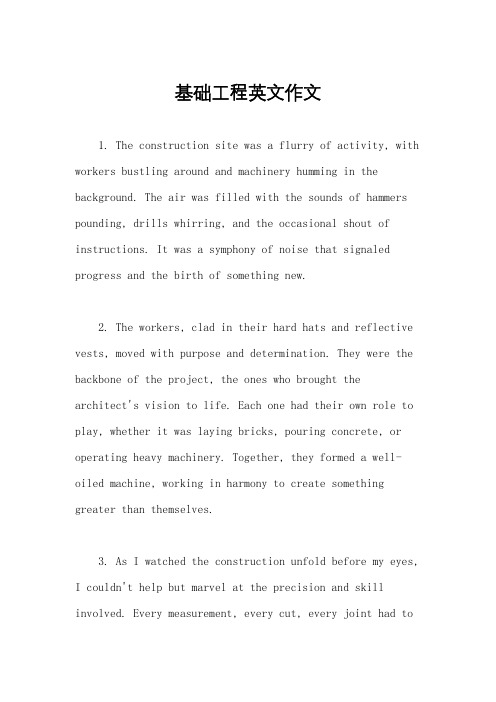
基础工程英文作文1. The construction site was a flurry of activity, with workers bustling around and machinery humming in the background. The air was filled with the sounds of hammers pounding, drills whirring, and the occasional shout of instructions. It was a symphony of noise that signaled progress and the birth of something new.2. The workers, clad in their hard hats and reflective vests, moved with purpose and determination. They were the backbone of the project, the ones who brought thearchitect's vision to life. Each one had their own role to play, whether it was laying bricks, pouring concrete, or operating heavy machinery. Together, they formed a well-oiled machine, working in harmony to create something greater than themselves.3. As I watched the construction unfold before my eyes,I couldn't help but marvel at the precision and skill involved. Every measurement, every cut, every joint had tobe perfect. It was a testament to the expertise of the workers and their commitment to quality. They took pride in their work, knowing that their craftsmanship would standthe test of time.4. The construction site was a melting pot of different trades and backgrounds. There were carpenters, electricians, plumbers, and painters, each bringing their own unique setof skills to the table. It was a diverse community, united by a common goal: to build something that would serve the needs of others. Despite their differences, they worked together seamlessly, learning from one another and finding common ground in their shared passion for construction.5. The construction site was a constant reminder of the power of collaboration. It was a place where ideas were shared, problems were solved, and friendships were forged. The workers relied on one another, trusting in each other's abilities and supporting one another through the ups and downs of the project. It was a testament to the strength of human connection and the importance of teamwork.6. The construction site was a living, breathing organism, evolving and changing with each passing day. It was a dance between progress and setbacks, with obstacles to overcome and victories to celebrate. It was a reminder that nothing worth having comes easy, and that hard work and perseverance are the keys to success.7. As the construction site neared completion, a sense of accomplishment filled the air. The once barren land had been transformed into a structure that would serve its purpose for years to come. It was a testament to the power of human ingenuity and the ability to create something from nothing. The construction site was a symbol of hope, a reminder that with determination and hard work, anything is possible.。
- 1、下载文档前请自行甄别文档内容的完整性,平台不提供额外的编辑、内容补充、找答案等附加服务。
- 2、"仅部分预览"的文档,不可在线预览部分如存在完整性等问题,可反馈申请退款(可完整预览的文档不适用该条件!)。
- 3、如文档侵犯您的权益,请联系客服反馈,我们会尽快为您处理(人工客服工作时间:9:00-18:30)。
J. Cent. South Univ. Technol. (2010) 17: 24−27DOI: 10.1007/s11771−010−0005−7Effect of heat treatment on microstructures and mechanical properties ofAl-6Zn-2Mg-1.5Cu-0.4Er alloyLIU Ying-ying(刘莹颖), XIA Chang-qing(夏长清), PENG Xiao-min(彭小敏)School of Materials Science and Engineering, Central South University, Changsha 410083, China© Central South University Press and Springer-Verlag Berlin Heidelberg 2010Abstract: The microstructures and mechanical properties of A1-6Zn-2Mg-1.5Cu-0.4Er alloy under different treatment conditions were investigated by transmission electron microscopy (TEM) observation, and tensile properties and hardness test, respectively. The relationship between mechanical properties and microstructures of the alloys was discussed. With trace Er addition to A1-Zn-Mg-Cu alloy, Er and Al interact to form Al3Er phase, which is coherent with α(Al) matrix. The results show that A1-Zn-Mg-Cu alloy after retrogression and re-ageing (RRA) heat treatment exhibits higher tensile strength, ductility and conductivity.Key words: Al-Zn-Mg-Cu alloy; Er; heat treatment; microstructures; mechanical properties; conductivity1 IntroductionAl-Zn-Mg-Cu alloys have been widely used as aircraft structure material because of their high strength- to-density ratio. However, these alloys generally have poor ductility and low fracture strength in the as-cast condition. So extensive processes, including a combination of heat treatment and hot working, are required to improve the mechanical properties [1]. Al-Zn-Mg-Cu alloys are typical ageing precipitate strengthening alloys and the ageing treatment is a key process to achieve the required microstructures and properties. T6 temper can obtain the peak hardness and tensile strength, with high stress corrosion cracking (SCC) susceptivity, which has a positive relationship with the variation of electrical conductivity [2]. T76 temper increases the stress corrosion resistance of Al-Zn-Mg-Cu alloys by modifying microstructures, although there exists certain sacrifice in tensile properties compared with T6 temper [3−4]. Retrogression and re-ageing (RRA) heat treatment can enhance the SCC resistance, while retaining the T6 strength of 7075 alloy [5−6], which is a popular heat treatment for Al-Zn-Mg- Cu alloys.Also, many researches show that with reasonable rare earth additions the properties of Al and its alloys can be remarkably improved.Recently, Er has been considered as the most popular minor alloying element to take place of Sc for Al-Mg and Al-Zn-Mg alloys [7−8]. YANG et al [9] found that with a small amount of Er addition to high pure Al or its alloys, Er can directly react with Al to form primary Al3Er particles. With the similar crystal lattice type (L12), parameter of Al3Er particles to Al matrix (FCC, crystal parameter a=0.404 9 nm) and rather small mismatch (about 4.1%), Al3Er particles that are coherent or semi-coherent with the matrix, have positive and resemble effects. ZHAO et al [10] found that in Al-Zn-Mg-Cu-Er alloys Er is mainly in the form of Al3Er, and small Al3Er phase can be used as the core of heterogeneous nucleation and then improve the mechanical properties of aging state alloy.The purpose of the present work is to investigate the ageing behavior of Al-Zn-Mg-Cu-0.4Er alloy and to understand the ageing strengthening mechanism in different ageing conditions, as well as the effect of Er addition on the mechanical properties of Al-Zn-Mg-Cu alloys.2 ExperimentalThe experimental alloys with the compositions (shown in Table 1) were melted in the resistance furnace and poured into cast iron mold. The obtained alloys were d50 mm ingots. Then, the ingots were homogenized at 460 ℃ for 24 h, and cooled in air. After that, the homogenized ingots were rolled into 2.0 mm-thick sheets at 430 ℃. Then, obtained samples from the above mentioned sheets were treated at 470 ℃ for 120 min, and then water quenched. After that, the samples were aged at 120 ℃ for 36 h. Finally, the samples were heat-treated with T6, T73 and RRA. The detailed conditions of theFoundation item: Project(2005CB623706) supported by the National Basic Research Program of China Received date: 2009−03−09; Accepted date: 2009−09−07Corresponding author: XIA Chang-qing, Professor; Tel: +86−731−88830267;E-mail: xia_gro@heat treatments are listed in Table 2.Table 1 Compositions of experimental alloys (mass fraction, %)Alloy No. Zn Mg Cu Er Al1 6.0 2.0 1.5 0 Bal.2 6.0 2.0 1.5 0.4 Bal.Table 2 Detailed conditions of heat treatments for alloys Temper Solid solution and aging treatmentT6 470℃, 2 h; WQ; 120 ℃, 24 hT76 470℃, 2 h; WQ; 120 ℃, 8 h; 160 ℃, 16 h RRA T6 ageing; 170 ℃, 60 min; 120 ℃, 24 h Note: WQ represents water quench.Microstructures of the samples were observed by transmission electron microscopy (TEM). The thin foils were prepared by double-jet and observed on a Tecnai Gz 20 microscope at 200 kV. The mechanical testing was performed on a universal tensile testing machine of CSS−44100 type at room temperature. Vickers micro- hardness measurements were performed by using a loadof 50 g Vickers hardness. The SCC trend of different heat-treated alloys was identified by conductivity testing.3 Results and discussion3.1 Aging curveFig.1 shows the ageing response of the alloys at 120 ℃. In Fig.1, the age-hardening curves show the basic states of under-aged, peak-aged and over-aged. First, the hardness increases gradually with the increaseof aging time. The peak hardness of alloy 2 is HRB179at 120 ℃, which is increased by HRB30 compared with that of alloy 1. The ageing time to achieve peak hardnessof alloy 2 is 24 h, which is 4 h less than that of alloy 1.The microstructures of alloy 2 after ageing at 120 ℃for 24 h (T6 temper) are shown in Fig.2. It canFig.1 Aging curves of alloys at 120 ℃Fig.2 TEM images of Al-6Zn-2Mg-1.5Cu-0.4Er alloy aged at 120 ℃ for 24 h (T6 temper): (a) η′ precipitates; (b) Al3Er precipitatesbe seen that very fine precipitates distribute homogeneously in the matrix (Fig.2(a)). Fig.2(a) indicates that the strengthening mechanism of the peak-aged alloy is the η′ phase strengthening.The fine Al3Er precipitates are found to be on the nanometer scale after solid solution and T6 (Fig.2(b)). In the course of subsequent homogenization of the ingot, the supersaturated solid solution decomposes under thermal activation, and forms secondary precipitates of the dispersed intermetallic Al3Er. These particles strongly pin sub-grain boundaries and dislocations, hinder the movement of the dislocation and sub-grain boundary migration, and increase the tensile strength of the alloy [10]. The strengthening mechanism of Al-6Zn-2Mg-1.5Cu-0.4Er is considered as fine grain strengthening and dispersion strengthening by Al3Er.3.2 Mechanical properties and electrical conductivityThe mechanical properties and electrical conductivities of Al-6Zn-2Mg-1.5Cu-0.4Er alloy under different conditions are listed in Table 3. The tensile strength (σb) after T6 temper is 577.12 MPa, and theelongation (δ) is 11.8%. It is found that the electricalconductivity (γ) of the samples has a remarkable increase after T76 treatment (23.0 MS/m) compared with that after T6 treatment (18.4 MS/m). According to Ref.[11], electrical conductivity serves as an indicator of corrosion resistance, that is, higher electrical conductivity means that the material has better SCC performance. It suggests that the SCC resistance of the alloy obtained by the T76 temper is higher than that obtained by the peak-aged (T6 temper). After RRA treatment, the tensile strength of the alloy slightly decreases compared with that after T6 temper, and electrical conductivity of the alloy is almost the same as that after T76 temper. Considering the factors of mechanical property and corrosion resistance property, the alloy after RRA treatment is regarded as the one with the most excellent property.Table 3 Tensile properties and electrical conductivity of Al-6Zn-2Mg-1.5Cu-0.4Er alloyCondition σb/MPa σ0.2/MPa δ/% γ/(MS·m−1) T6 577.12 514.96 11.8 18.4 T76 504.43 455.43 9.6 23.0 RRA 563.39 483.68 11.2 22.1The complete ageing sequence in a wide range of ternary compositions during the ageing heat treatment is as follows: supersaturated solid solution—GP (Zn, Mg) zones—η′ (hexagonal)—η(MgZn2, hexagonal) [12]. These series of alloys provide high strength in the T6 condition. Multi-stage heat treatments provide a means for modifying the size, composition, species, morphology and distribution of precipitate particles in aged aluminum alloys. These changes result in the improvement of mechanical properties [13]. TEM images of samples under different ageing tempers are shown in Fig.3. Fig.3 demonstrates the presence of the η′phase, which is the main strengthening phase under the ageing condition. Fig.3(a) shows the image of Al-Zn-Mg-Cu-0.4Er alloy after ageing at 120 ℃ for 24 h (peak-aged T6 condition), and reveals that fine precipitations homogeneously distribute in the matrix. The precipitates at grain boundary mainly belong to ηphase with continuous distribution. Fig.3(b) shows the image of the alloy after solid solution and T76 treatment.It can be seen from Fig.3(b) that the precipitates in the matrix increase remarkably and the precipitation density is very low. Then, it is not surprising that the alloy possesses low tensile strength under this ageing temper. Furthermore, the grain boundary precipitates, recognized as η phase [14], grow up to be coarser and are more sparsely distributed, and the precipitate free zone (PFZ) with about 50 nm in width can also be observed. Fig.3(c) shows the TEM image of the alloy after RRA treatment.Fig.3 TEM images of Al-Zn-Mg-Cu-0.4Er alloy after different treatments: (a) At 120 ℃ for 24 h; (b) At 120 ℃ for 36 h;(c) RRAIt can be found that the precipitates in the matrix are very similar to those treated by the T6 temper, which are very fine and distributed homogeneously. Therefore, the tensile strength of the alloy after RRA temper is very close to that obtained by the T6 temper. The grain boundary characteristics are similar to those obtained by the T76 temper (Fig.3(b)) and the precipitates are coarse and discontinuously distributed. According to Ref.[15], the coarser and more discrete grain boundary precipitates are suggested to improve the SCC resistance. Thus, itmay be inferred that the RRA treatment is favorable for the SCC resistance of the alloy. Furthermore, apparent PFZ with 40−50 nm in width along the grain boundary can be observed.4 Conclusions(1) The optimum single-step aging treatment for Al-6Zn-2Mg-1.5Cu-0.4Er alloy is at 120 ℃ for 24 h (T6).(2) The rare earth element Er mainly exists in the form of Al3Er phase in Al-6Zn-2Mg-1.5Cu-0.4Er alloy. The secondary Al3Er precipitates from supersaturated solid solution that are coherent with the α(Al) matrix can strongly pin sub-grain boundaries and dislocations, hinder the movement of the dislocation and migration of sub-grain boundary and then increase the strength of the alloy.(3) The tensile strength, ductility and conductivity of Al-6Zn-2Mg-1.5Cu-0.4Er alloy after RRA treatment are 563.39 MPa, 11.2% and 22.1 MS/m, respectively. References[1] DAVIS J R. Aluminum and aluminum alloys, ASM specialtyhandbook [M]. Ohio: ASM International, 1993: 41−43.[2] WALLANDE W, BEDDOES J C, MALHERBE M C. A newapproach to the problem of stress corrosion cracking in 7075-T6aluminum [J]. Canadian Aeronautics and Space Journal, 1981, 27(3):222−232.[3] QU Bin-lung, YANG Ji-gang. Effect of step quench and aging onmechanical properties and resistance to stress corrosion cracking of7050 aluminum alloy [J]. Materials Transactions, JIM, 2000, 41(7):783−789.[4] WERENSKIOLD J C, DESCHAMPS A, BRECHET Y.Characterization and modeling of precipitation kinetics in an Al-Zn-Mg alloy [J].Materials Science and Engineering A, 2000,293(1/2): 267−274.[5] OLIVEIRA A F J, DE BARROS M C, CARDOSO K R,TRAVESSA D N. The effect of RRA on the strength and SCCresistance on AA7050 and AA7150 aluminium alloys [J]. MaterialsScience and Engineering A, 2004, 379(1/2): 321−326.[6] WARREN P J, GROVENOR C R M, CROMPTON J S. Field-ionmicroscope/atom-probe analysis of the effect of RRA heat treatmenton the matrix strengthening precipitates in alloy Al-7150 [J]. SurfaceScience, 1992, 266(15): 342−349.[7] MAO Jian-wei, JIN Tou-nan, XU Guo-fu, NIE Zuo-ren. As-castmicrostructure of Al-Zn-Mg and Al-Zn-Mg-Cu alloys added erbium[J]. Transactions of Nonferrous Metals Society of China, 2005, 15(6): 1341−1345.[8] XU Guo-fu, NIE Zuo-ren, JIN Tou-nan, YANG Jun-jun, FU Jian-bo,YIN Zhi-min. Effect of trace Er on the as-cast structure of LF3 aluminum alloy [J]. Journal of Rare Earths, 2002, 20(2): 143−150.(in Chinese)[9] YANG Jun-jun, NIE Zuo-ren, JIN Tou-nan, XU Guo-fu, FU Jing-bo,RUAN Hai-qiong, ZUO Tie-yong. Effect of trace rare earth elementEr on high pure Al [J]. Transactions of Nonferrous Metals Society ofChina, 2003, 13(5): 1035−1039.[10] ZHAO Zhong-kui, ZHOU Tie-tao, LIU Pei-ying, CHEN Chang-qi.TEM investigation of precipitations with Er in aging Al-Zn-Mg-Cu-Li-Er alloy [J]. Rare Metal Materials and Engineering, 2004, 33(10):1108−1111. (in Chinese)[11] LI Zhi-hui, XIONG Bai-qing, ZHANG Yong-an, ZHU Bao-hong,WANG Feng, LIU Hong-wei. Ageing behavior of an Al-Zn-Mg-Cualloy pre-stretched thick plate [J]. Journal of University of Scienceand Technology Beijing, 2007, 14(3): 246−250.[12] FRIDLYANDER I N, DOBROMYSLOV A V, TKACHENKO E A,SENATOROVA O G. Advanced high-strength aluminum-base materials [J]. Metal Science and Heat Treatment, 2005, 47(7/8): 269−275.[13] MILLER M P, HARLEY E J, TURNER T J, BEAUDOIN A J,CASSADA W A. Mechanical behavior of thin sheets machined fromAA7050-T7451 plate [J]. Materials Science Forum, 2000, 331/337(3): 1243−1248.[14] LI Yun-tao, LIU Zhi-yi, MA Fei-yue, XIA Qing-kun. Phaseconstitution and growth manner at grain boundary in Al-Cu-Mg- Ag-Er alloy [J]. Rare Metal Materials and Engineering, 2008, 37(6):1019−1022. (in Chinese)[15] PUIGGALI M, ZIELINSKI A, OLIVE J M, RENAULD E,DESJARDINS D, CID M. Effect of microstructure on stress corrosion cracking of an Al-Zn-Mg-Cu alloy [J]. Corrosion Science,1998, 40(4/5): 805−819.(Edited by CHEN Wei-ping)。
